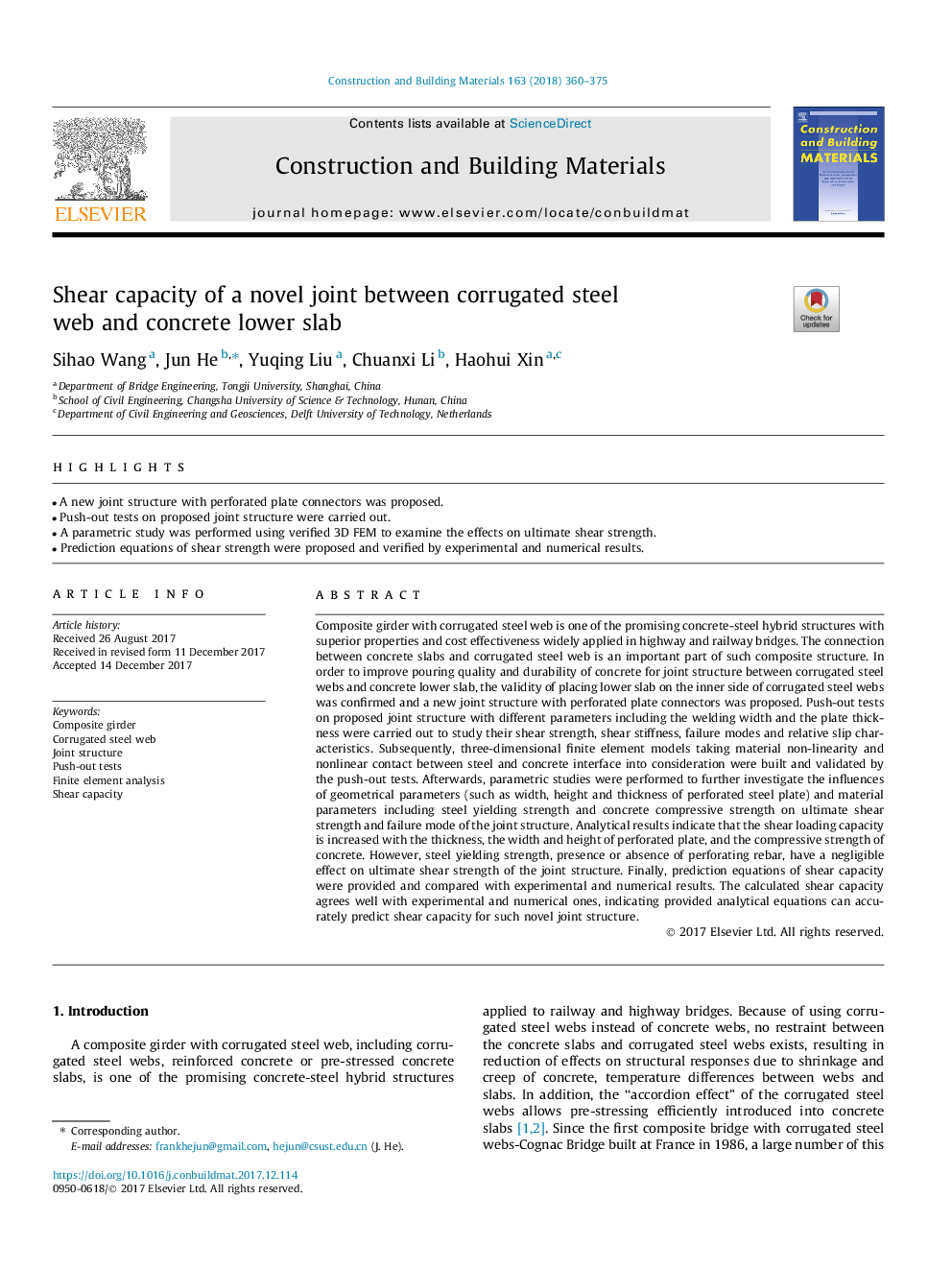| کد مقاله | کد نشریه | سال انتشار | مقاله انگلیسی | نسخه تمام متن |
|---|---|---|---|---|
| 6716234 | 1428743 | 2018 | 16 صفحه PDF | دانلود رایگان |
عنوان انگلیسی مقاله ISI
Shear capacity of a novel joint between corrugated steel web and concrete lower slab
ترجمه فارسی عنوان
ظرفیت برش یک اتصال جدید بین ورق فولادی موجدار و بتنی پایین تر بتن
دانلود مقاله + سفارش ترجمه
دانلود مقاله ISI انگلیسی
رایگان برای ایرانیان
کلمات کلیدی
تیر کامپوزیت، ورق فولادی ضد زنگ، ساختار مشترک، تست کشش، تجزیه و تحلیل عنصر محدود، ظرفیت برش،
ترجمه چکیده
محفظه کامپوزیت با ورق فولادی موجدار یکی از ساختارهای هیبریدی بتنی است که دارای خواص برتر و اثربخشی هزینه در پل های بزرگراه و راه آهن است. اتصال بین اسلب بتنی و ورق فولادی موجدار، بخش مهمی از ساختار کامپوزیت است. به منظور بهبود کیفیت ریختن و دوام بتن برای ساختار مشترک بین ورق های فولادی قرقره و زیرین بتونی، اعتبار قرار دادن ورقه های پایین تر بر روی ورق فولادی ورق فولادی تأیید شد و ساختار جدیدی با اتصالات ورق های سوراخدار ارائه شد. آزمونهای کششی بر روی ساختار پیشنهاد شده با پارامترهای مختلف از قبیل عرض جوشکاری و ضخامت ورق برای بررسی مقاومت برشی، سختی برشی، حالت شکست و خصوصیات لغزش نسبی انجام شده است. در ادامه، مدل های عنصر محدود سه بعدی با توجه به غیر خطی بودن مواد و تماس غیرخطی بین رابط فولادی و بتنی، با استفاده از آزمون های کششی ساخته و ساخته شدند. پس از آن، مطالعات پارامتری برای بررسی بیشتر تأثیر پارامترهای هندسی (مانند عرض، ارتفاع و ضخامت ورق فولادی سوراخ شده) و پارامترهای مواد از جمله مقاومت فولاد و مقاومت فشاری بتن بر مقاومت نهایی برشی و حالت شکست ساختار مفصل انجام شد. نتایج تحلیلی نشان می دهد که ظرفیت بارگذاری برش با ضخامت، عرض و ارتفاع ورق سوراخ شده و مقاومت فشاری بتن افزایش می یابد. با این حال، مقاومت فولاد، وجود یا عدم وجود میلگرد سوراخدار، تأثیر ناچیزی بر مقاومت برشی نهایی ساختار مشترک دارد. در نهایت، معادلات پیش بینی ظرفیت برشی ارائه شده و با نتایج تجربی و عددی مقایسه شده است. ظرفیت برشی محاسبه شده به خوبی با آزمایش های تجربی و عددی همخوانی دارد، که نشان می دهد معادلات تحلیلی ارائه شده می توانند ظرفیت برش را برای چنین ساختار جدیدی به طور دقیق پیش بینی کنند.
موضوعات مرتبط
مهندسی و علوم پایه
سایر رشته های مهندسی
مهندسی عمران و سازه
چکیده انگلیسی
Composite girder with corrugated steel web is one of the promising concrete-steel hybrid structures with superior properties and cost effectiveness widely applied in highway and railway bridges. The connection between concrete slabs and corrugated steel web is an important part of such composite structure. In order to improve pouring quality and durability of concrete for joint structure between corrugated steel webs and concrete lower slab, the validity of placing lower slab on the inner side of corrugated steel webs was confirmed and a new joint structure with perforated plate connectors was proposed. Push-out tests on proposed joint structure with different parameters including the welding width and the plate thickness were carried out to study their shear strength, shear stiffness, failure modes and relative slip characteristics. Subsequently, three-dimensional finite element models taking material non-linearity and nonlinear contact between steel and concrete interface into consideration were built and validated by the push-out tests. Afterwards, parametric studies were performed to further investigate the influences of geometrical parameters (such as width, height and thickness of perforated steel plate) and material parameters including steel yielding strength and concrete compressive strength on ultimate shear strength and failure mode of the joint structure. Analytical results indicate that the shear loading capacity is increased with the thickness, the width and height of perforated plate, and the compressive strength of concrete. However, steel yielding strength, presence or absence of perforating rebar, have a negligible effect on ultimate shear strength of the joint structure. Finally, prediction equations of shear capacity were provided and compared with experimental and numerical results. The calculated shear capacity agrees well with experimental and numerical ones, indicating provided analytical equations can accurately predict shear capacity for such novel joint structure.
ناشر
Database: Elsevier - ScienceDirect (ساینس دایرکت)
Journal: Construction and Building Materials - Volume 163, 28 February 2018, Pages 360-375
Journal: Construction and Building Materials - Volume 163, 28 February 2018, Pages 360-375
نویسندگان
Sihao Wang, Jun He, Yuqing Liu, Chuanxi Li, Haohui Xin,
